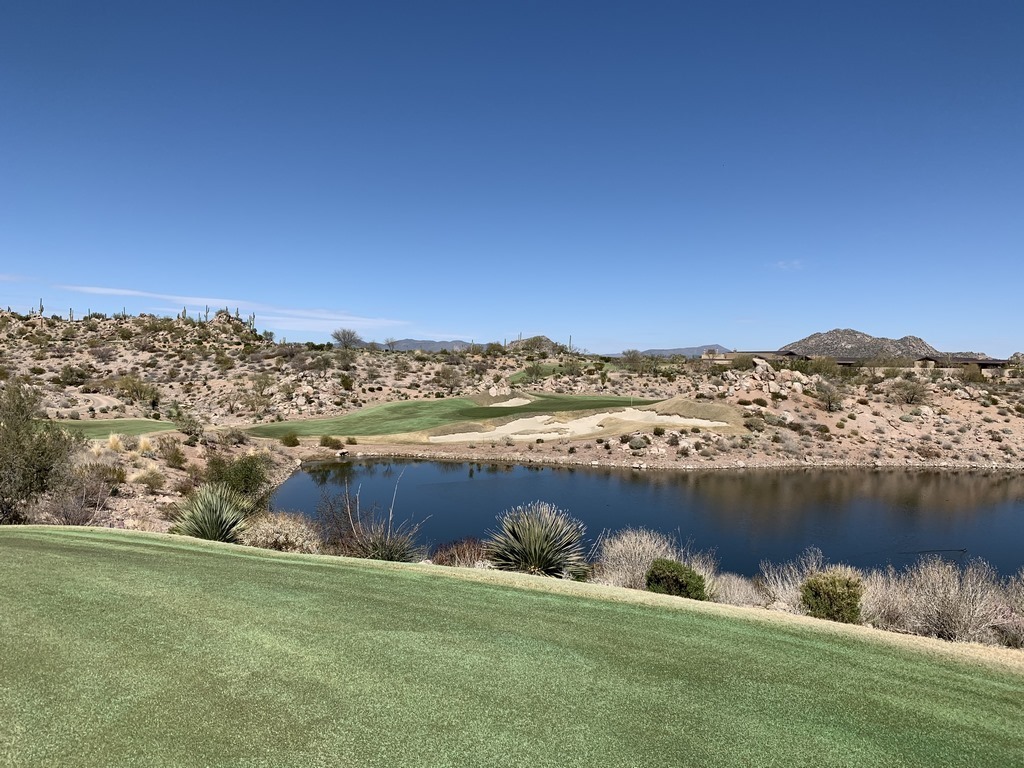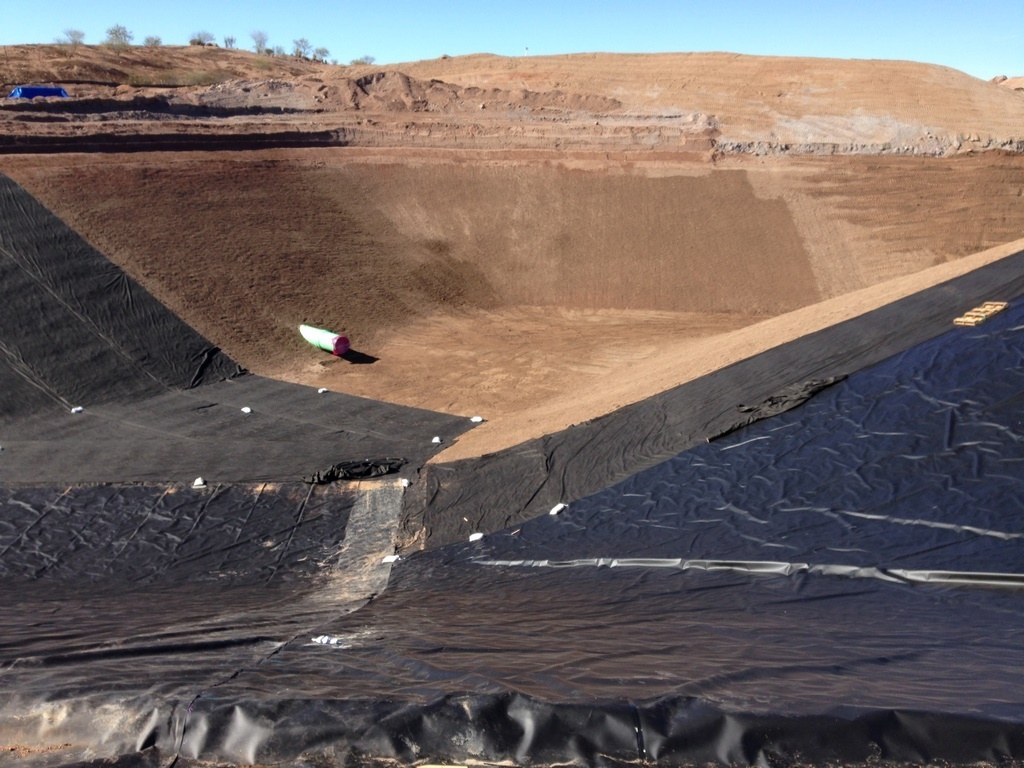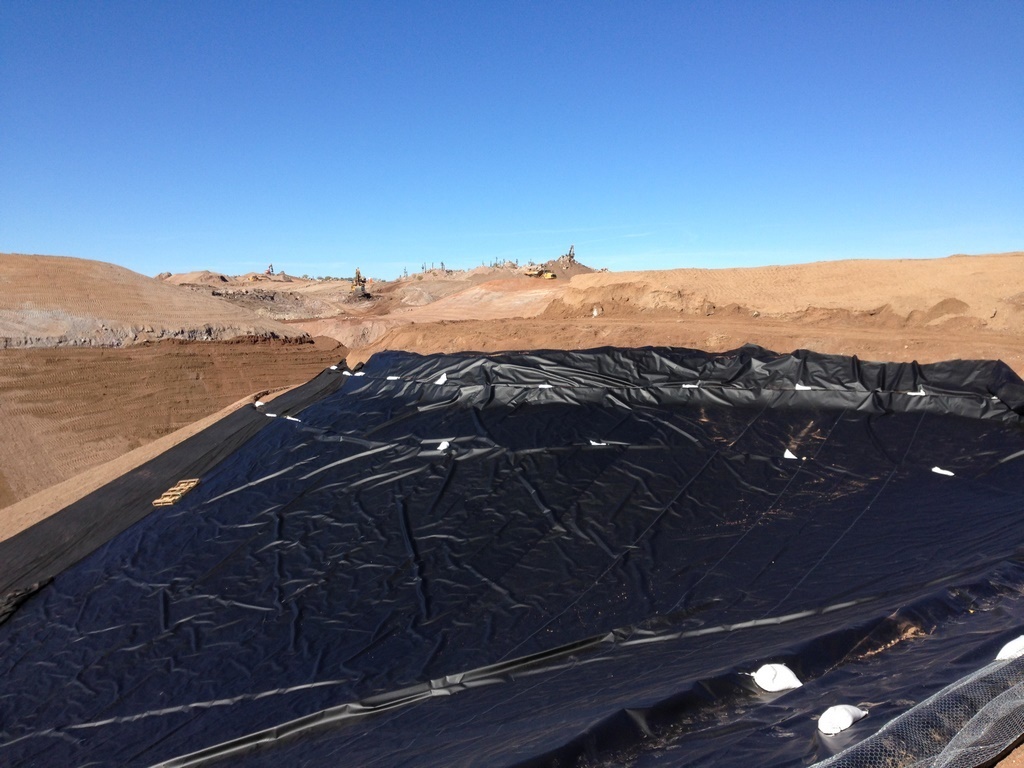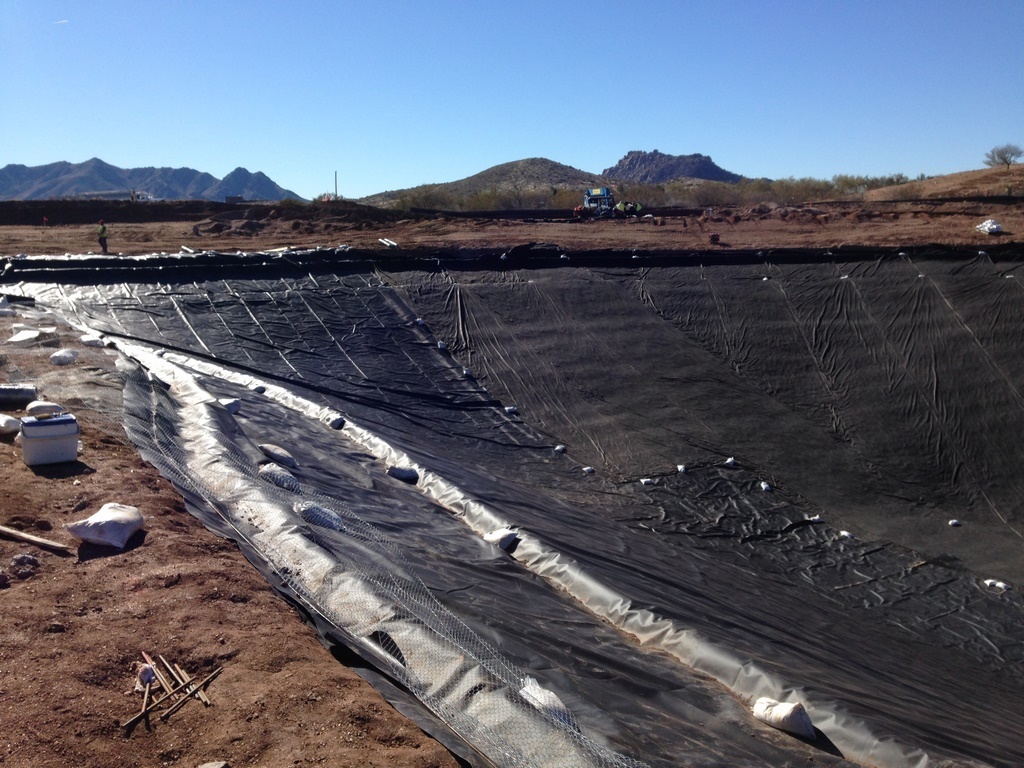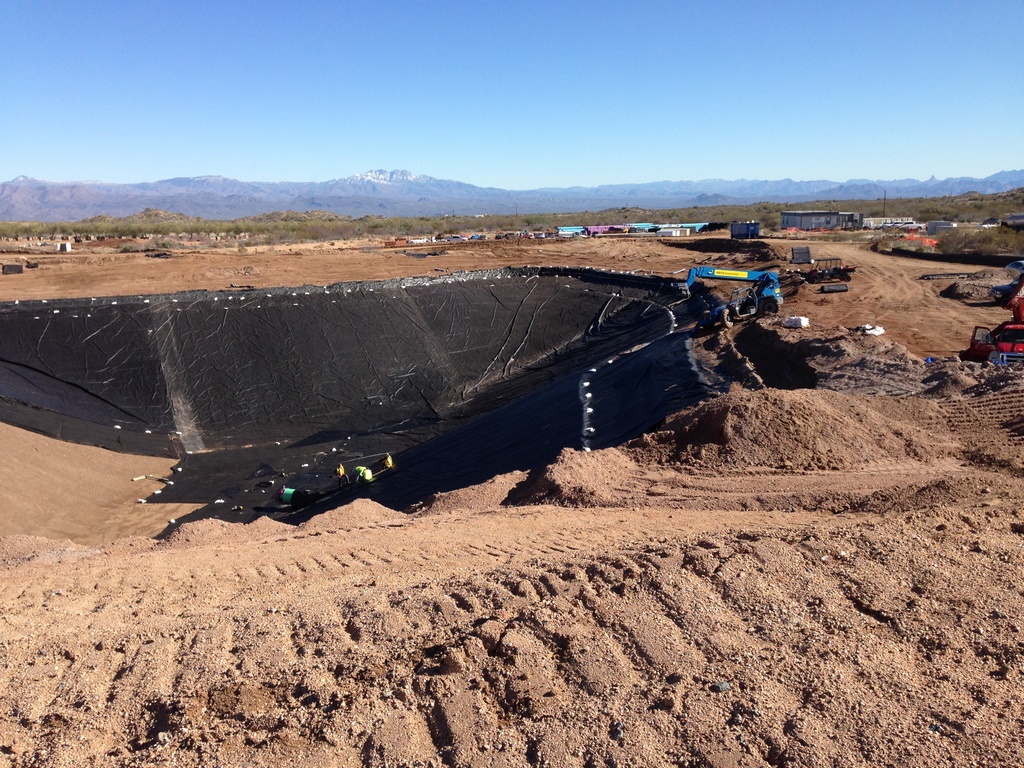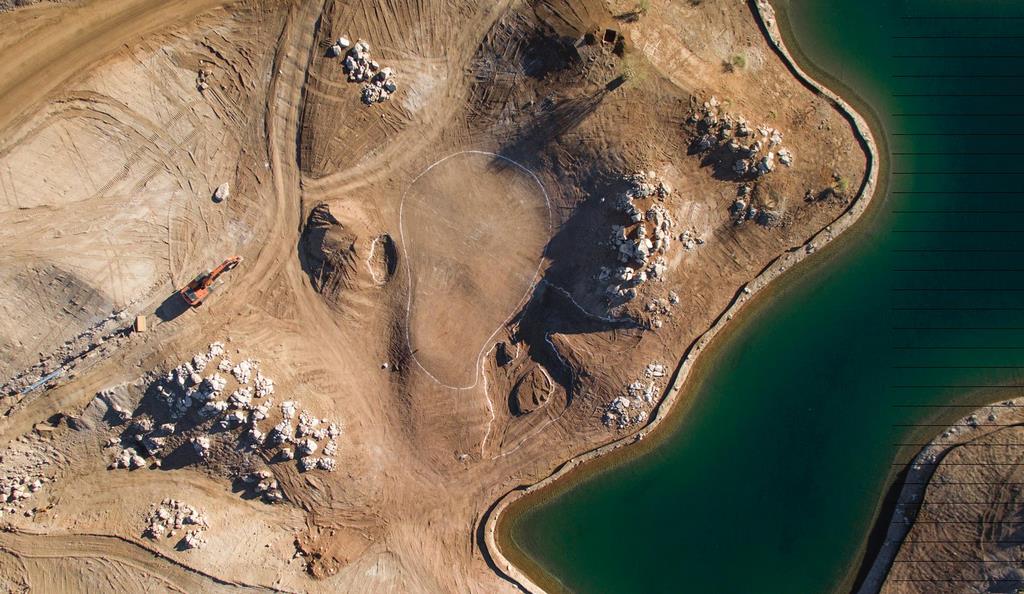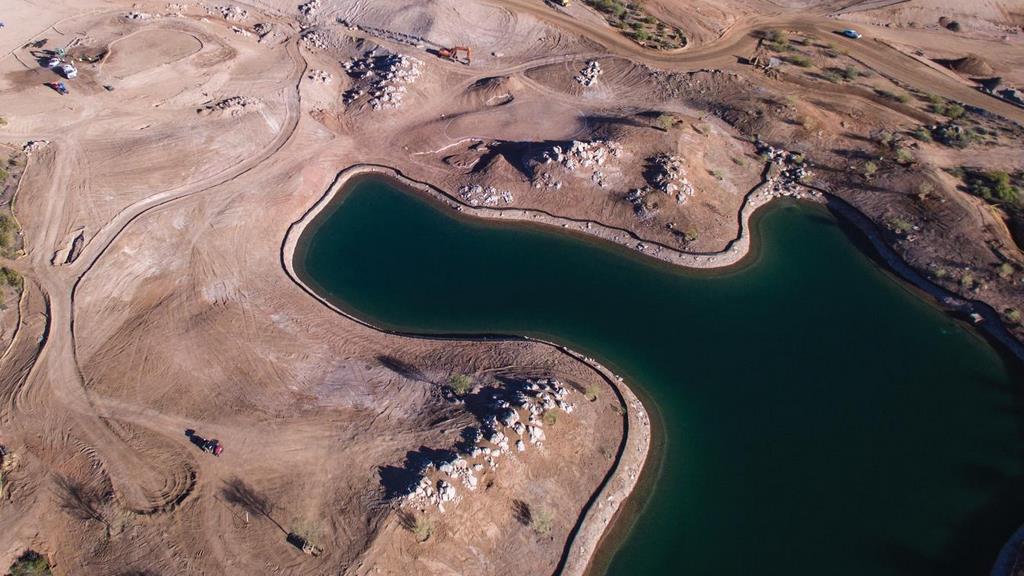Demise of the Water Hazard

There’s no question that watershapes have become scarce on new golf courses. Where owners and designers once tried to one-up each other in terms of elaborate course design, including the expansive use of lakes, ponds, streams and waterfalls, today minimalism is the guiding principle, meaning water is rarely part of the program.
There are exceptions, of course, but they are extremely few and far between. As one example, we completed a project back in 2016 that included a 23-million gallon irrigation lake that is also an amenity/hazard. Located at the Scottsdale National Golf Club (SNGC) in Scottsdale, Ariz., it’s the only significant watershape we’ve created in the last five years.
The lake was part of a complete makeover of the property, which was purchased by Bob Parsons, founder of GoDaddy.com and Parsons Xtreme Golf, back in 2013.The existing club was in financial trouble when it was purchased, but the existing course that was in pretty good shape and Parsons purchased tracks of land adjacent to the existing club that had been graded clean for housing pads and roads. He wanted to create a unique golf experience by completely re-imagining, rebuilding and re-branding the property, which now has three courses, two 18-hole par-72 courses, and one nine-hole course (considered the most difficult in the world) – and a host of high-end amenities.
The lake is on the 9th hole of the new 18-hole course, prosaically named by Parsons, “The Other Course.” At 3.5 acres and 30 feet deep, all in solid rock, the installation was a sizable challenge. We worked closely with course designer, David Kahn of Jackson Kahn Design, to establish the lake in the lowest part of the course, in an effort to make it appear as natural as possible. Our firm then designed large tracks of Sonoran Desert landscape that nestle the new golf holes, and the lake, along with the courses’ newly created massive land forms.
More on the SNGC project below, but first to understand how we came to this dry time in golf, it helps to look back at the history of golf-course design. Here’s the short version:
FROM THE PASTURE
When golf took hold in the U.S. in the early 20th Century, there was a golden age of course construction. It was an era when many of the most famous courses were created, some that have become household names, but what most people might not realize is that it was very minimalist in terms of how courses existed within the natural landscape.
In the very early days, courses were graded using oxen and carts, so it was practically impossible to completely re-contour the entire landscape. Instead, designers looked for ways to use the existing landscape to create golf holes in stretches of pasture, while using the natural topography to create interest and variety.
Even when reshaping the land became possible with modern excavation equipment, through the majority of the 20th Century course design still followed this model where the layout and topography mostly conformed to the landscape. Our most iconic courses are based on that model, from Augusta to Pebble Beach and countless others, the art of course design was about celebrating the environment and drawing you into the landscape. The industry was served well by that approach, which led to great golf facilities and steady expansion of the game as both a spectator and participation sport.
| The Scottsdale National Golf Club features stunningly scenic golf holes set in a meticulously restored Sonoran Desert landscape. Aside from the irrigation lake described in this discussion, there are no water hazards or features of any kind. |
Then came the 1980s. That was when golf exploded in popularity and the great era of completely artificial courses took hold. It was also the golden age of man-made water and golf. The sport was expanding rapidly and there was what seemed like a mad rush to create amazing courses in otherwise unremarkable landscapes. You skinned the land and then built an entire environment from scratch, making it look as natural as possible and in many cases, as outlandish as you could imagine.
Our company thrived in this era creating landscapes and water features on these types of projects, many of which have been featured in past WaterShapes editions. Through the 90s and into the early 2000s, it was if there were no limits and the popularity of golf would continue growing forever. As we now know, that would not last.
OVER THE PEAK
Golf’s popularity crested in 2005 when some 30 million people in the U.S. were regular players. This was a time when Tiger Woods was arguably the most popular and successful athlete in the world and ratings for televised tournaments were at an all-time high.
All of a sudden, right at that peak, owners and designers became more concerned with cost and environmental sustainability. That led to what seemed like an overnight transition back to a far more minimalist approach to design and construction. It was also the time we started to see golf’s popularity trending downward. In the 20 years prior to the peak, according to the National Golf Foundation (NGF), there were 4,657 courses built in the U.S., a period that added a whopping 44% capacity to the sport. Kahn is among those who believe the market became over-saturated. (See his comments in the side bar below.)
Since then, only about 500 new courses have been built with many being shuttered. According to the NGF, since that ’05 peak, the sport has lost about 10 million participants in the U.S. Certainly, the great recession beginning in 2008 had a negative impact, especially since housing development slowed, which stymied the number of courses built as part of new housing tracts. Also, climactic changes and droughts have taken a toll on the golf course industry as increasing water costs have caused many courses to either close or drastically reduce turf areas in an attempt to survive. Obviously, many have not.
| The irrigation lake’s construction was an undertaking of massive proportions. Four months of dynamite and excavation yielded vast amounts of spoils that we used to construct land forms throughout the property. |
Since the recession, nearly all of the courses that have been built have followed the original minimalist concept, and virtually none have included aesthetic water features other than irrigation lakes.
It bears mentioning that golf has experienced the first increase in participation in 2019, the first in 14 years, according to the NGF. Whether or not that continues no one knows, but it’s difficult to imagine the sport returning to its peak popularity anytime soon. For now, combining the minimalist design trend and declining number of new courses, it’s easy to see how watershaping in golf has almost become a thing of the past.)
GOING DEEP
The SNGC was an unusual project in many ways and in some respects may represent the type of marketing and branding needed to revitalize the sport. Parsons is a proven marketing genius and he is injecting energy, creativity and capital into the game, all of which is reflected in the fun and innovative nature of the property. And, he is also very determined to support the sustainability of the courses themselves.
In our role, we were building much of the SNGC landscape from scratch, but it was all with the strictest adherence to the indigenous desert landscape. Like many courses these days, one of the guiding principles for the entire project was to act as a responsible steward of the environment, which resulted in this vast restoration of the property’s landscape. And, there was this need for an irrigation lake to store water to sustain the turf and new landscaping.
In the Scottsdale/Phoenix you’re limited to 2.3 acres of water surface area per 18 holes. The original course, which was rebuilt and now named “The Mine Shaft,” has its own reservoir. That meant with the new 18-hole and the nine-hole courses, along with the practice areas, we were able to get the allowable number for the new lake’s surface area up to 3.5 acres.
According to Kahn, Parsons had originally considered building an underground reservoir, thus eliminating loss from evaporation. The cost was prohibitive, and especially so in comparison to the cost of replacing evaporative loss. So, after great discussion, the project team moved toward the exposed surface solution. The catch was that Parsons insisted on making the facility drought and water-shortage resistant by way of massive storage capacity.
Most irrigation lakes on golf courses are only between 8-to-10 feet deep, which would’ve given this lake a capacity less than 10 million gallons. Because Parsons insisted on as much volume as possible, the only way we could go was down. As a result, we went 30 feet deep, and now the lake roughly holds 23 million gallons of water.
| The painstaking construction process resulted in lake with an undulating shape that provides shifting views from different locations. The adjacent landforms were put in place before the holes were built, creating vertical transitions on what was once a flat site. |
Parsons also wanted to make it look as natural as possible, and as Kahn pointed out, nature builds lakes in the low spots. Lakes look contrived on many courses because they build berms of land and then fill it with water. The resulting vessel essentially sits on top of the existing grade. It’s less expensive to build it that way because you don’t have to dig, but it almost always looks unnatural. That’s why on this project, the surface of the lake was established a full 30 feet below the playing surface. That meant we had go down a combined 60 feet.
Unfortunately, on this site, you hit solid rock two feet below grade. That resulted in four months of dynamite blasting. It was a dramatic process that generated vast amounts of spoils in the form of large boulders and sandy soil, which we in turn used to contour the course and many of the massive landforms seen around the property. In some places we took flat land and created elevation changes by excavating below grade and then building up the area right next to it, in some cases creating 90-foot grade changes on what was originally a flat site.
Now, it looks as though the courses were just dropped into this beautiful existing desert landscape, but in fact it’s all man-made.
A UTILITARIAN BEAUTY
The lake is nestled around the 9th hole and is designed with the views from the course in mind. It has an undulating free-form shape that provides shifting views from different vantage points. It’s purposefully made so that you can’t see the entire lake from any one vantage point, so there’s sense of mystery and discovery as you move around it. When you see an entire lake from any location, your eye tells you that it’s only so big. When you cannotsee the entire thing, you get the impression that you’re seeing only part of what might be a much larger body of water.
|
STATE OF PLAY In preparing this discussion, we spoke with designer David Kahn, who offered a number of insightful comments both about the lake at the Scottsdale Nation Golf Club, and the state of the sport in general. Here’s some of what he had to say. ‘Golf is an interactive landscape. There’s no other environment like it. It’s a wonderfully complex game and a complex puzzle in terms of all the elements that have to work together to create a successful property. Unfortunately, golf as an industry has been oversaturated. There’s too much product and in my opinion far too many uninspired, ho-hum courses that don’t motivate people to get out and play or take up the sport. As those of us who play know, golf is an extremely humbling, difficult and frustrating sport. That’s why courses need to provide a unique experience to keep players coming back. There’s also definitely been a need to rethink golf courses from a sustainability perspective. A poorly executed project can harm the landscape, no question. On the other hand, it’s also true that successful and well-thought-out projects almost always benefits the environment. The property that is now the SNGC and providing an entirely unique golf experience. The site was already largely destroyed or in a pseudo natural state, at best. A fire had ripped through the property about 20 years prior and had decimated the natural desert landscape, so it was not a thriving environment. There was a lot of decay and it was a far cry from a healthy natural landscape. A big part of our project entailed rebuilding the natural landscape and then putting a golf course on it. We worked closely with Pinnacle Design who restored the Sonoran Desert environment with tremendous attention to detail. Now the amount of wildlife that has returned is unreal, the flora and fauna are mind-blowing. If it wasn’t for the golf course, it would probably be a housing development, but because of the course, it’s an amazing, thriving environment. The last time we designed a water feature, a stream specifically, was nine years ago. There are different reasons for that shift. I believe a big factor is the cost of upkeep, maintenance and utility costs. Golf itself is not that profitable; most courses are making their money on food and beverage and hospitality, things they sell once people are on the property. So, when you spend less on maintenance and utilities it falls directly to the bottom line. These days, the only water we work with is natural water. Whether or not that will change is impossible to predict.’ |
We also knew that the lake would fluctuate in depth based on the amount of water taken out for irrigation, versus how long it takes to replenish. (Roughly speaking, the course will use about 500,000 gallons per day, in the summer it’s about 1.1 million.) Because no one wanted to see the concrete banding around the edges when the lake was low, we installed a natural-looking, cobble edge-treatment that descends into the lake, regardless of the water level.
The idea was to make it look like that water had naturally eroded the soil. Because the edges are so steep, the surface area of the lake doesn’t really change as the depth goes up and down. The downside to the vertical edge is that it can have kind of a toilet bowl look when the water is drawn down, which is why in the past we’d often go with shallow edges so the lake more gently fuses with the landscape.
Here we tried to make the edges look as natural as possible even though they’re very steep. It was bit of a visual balancing act in that sense. We always want a decorative edge that doesn’t look man-made, but at the same time, it has to function as an edge that doesn’t erode.
The lake is fed using reclaimed water from the local utility that has gone through a reverse osmosis treatment process. We put in a number of subsurface aerators to support dissolved oxygen levels as well as break up the thermocline ( trying to mix the cool water at the bottom of the lake with the warm water at the surface). And, we installed emergent plantings that will remove organics and help sustain quality water conditions.
The real achievement here is a world class golf course design surrounded by a completely created natural golf environment. The SNGC is a truly unique course with all sorts of interesting holes, a beautiful new clubhouse, spa facilities and guest villas. The lake may not be the most elaborate watershape we’ve ever created on a golf course, but it’s one that serves the sustainability of the 45-hole facility and its beauty, as well.
Ken Alperstein is the President and co-owner of Pinnacle Design Company based in La Quinta , Calif., a landscape architectural firm that specializes in golf course landscape and water feature design. He is a registered landscape architect since 1991 and has practiced all types of landscape designs since starting in the profession in 1985. Over the years, Alperstein has helped designed spaces for UN headquarters, business parks, prominent high-rise buildings, hospital and college campuses, large-scale housing developments, resorts and hundreds of private residences.










